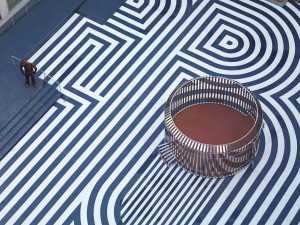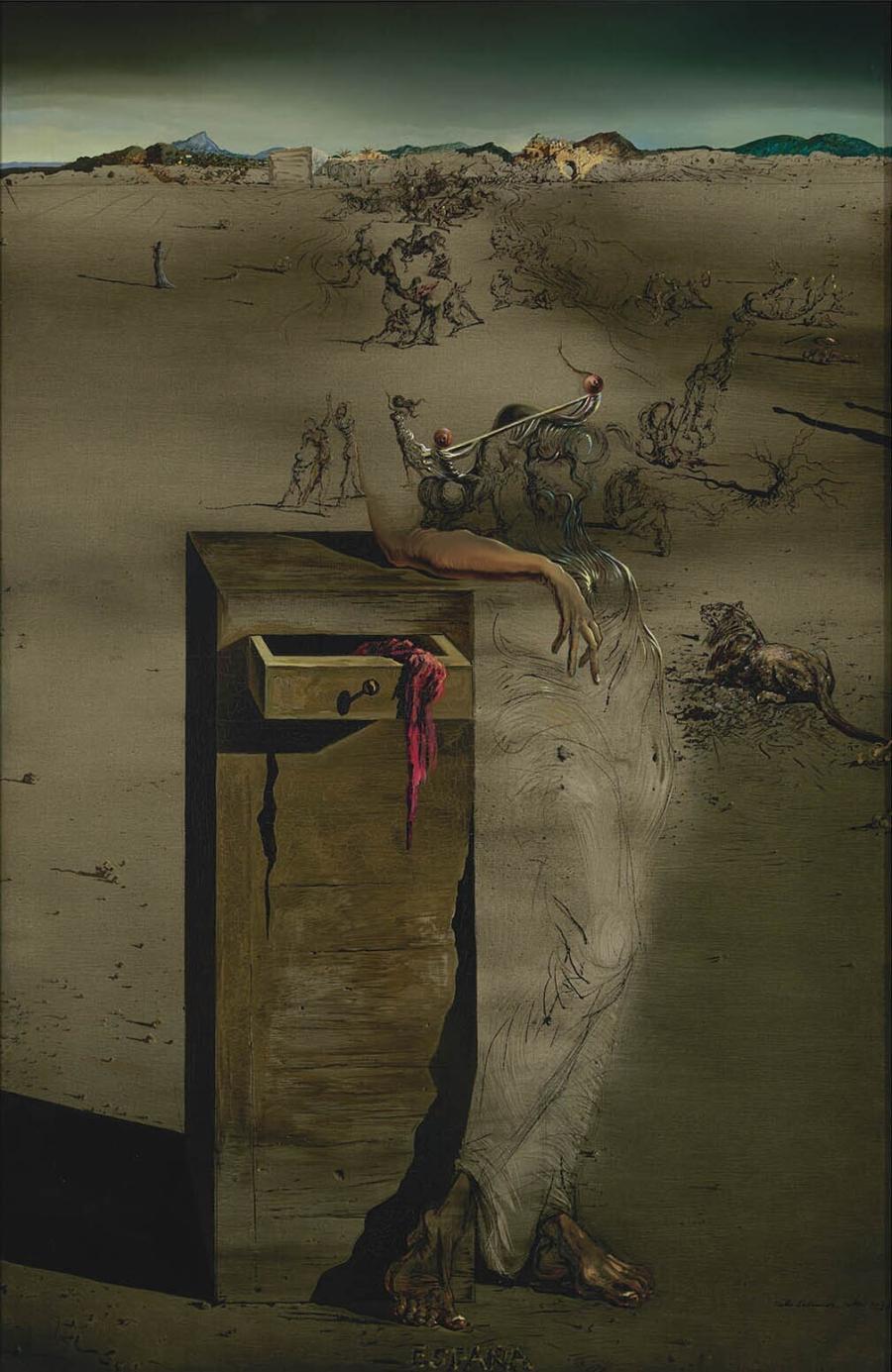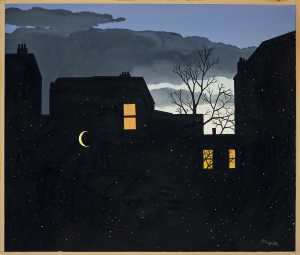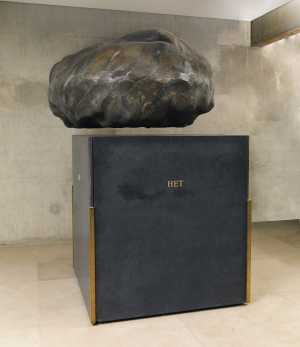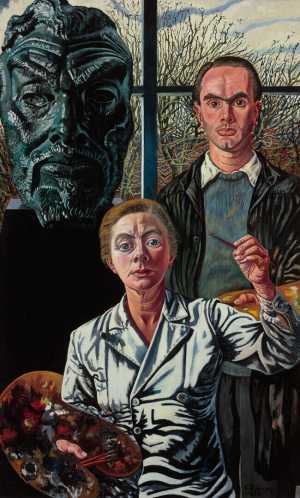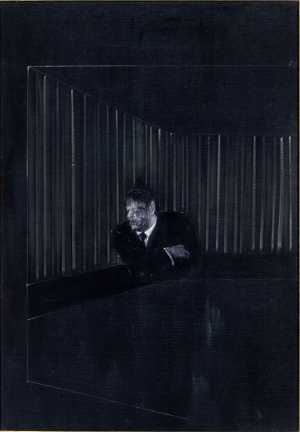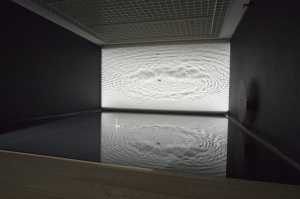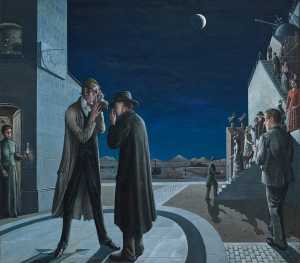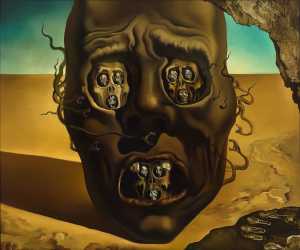In this double image, Dali gives a Spain torn apart by war the allegorical form of a woman. The woman's head is both foreground and background, figure and landscape. The hair, the face and the nipples are composed of fighting horsemen, inspired by the studies Leonardo da Vinci made of horsemen. The graceful pose of the woman is derived from a 19th century French canvas.

Specifications
| Title | Espagne |
|---|---|
| Material and technique | Oil on canvas |
| Object type |
Painting
> Painting
> Two-dimensional object
> Art object
|
| Location | This object is in storage |
| Dimensions |
Height 91,8 cm Width 60,2 cm |
|---|---|
| Artists |
Artist:
Salvador Dalí
|
| Accession number | 2990 (MK) |
| Credits | Purchased with the support of Stichting Museum Boijmans Van Beuningen, Rembrandt Association, Cultuurfonds, Erasmus Foundation, and Stichting Bevordering van Volkskracht, 1979 |
| Department | Modern Art |
| Acquisition date | 1979 |
| Creation date | in 1938 |
| Collector | Collector / Edward James |
| Entitled parties | © Salvador Dalí, Fundación Gala-Salvador Dalí, c/o Pictoright Amsterdam 2022 |
| Provenance | Edward James, Chichester 1938-67; New Trebizond Foundation, Los Angeles 1967-79; on loan to Museum Boijmans Van Beuningen, Rotterdam 1972-79 |
| Exhibitions | New York 1939; Indianapolis 1942; Detroit 1943; Dallas 1948; New York 1965; Rotterdam 1970-71; Rotterdam 1972a; Paris 1979; London 1980; Barcelona/Madrid 1983; London 1985; Stuttgart/Zurich/Humlebaek 1989-90; Paris 1997; Brighton 1998; Madrid 2002; Venice/Philadelphia 2004-05; London/Rotterdam/Bilbao 2007-08; Milan 2010-11; Kassel 2012; Rotterdam 2013-14a; Edinburgh/Hamburg/Rotterdam 2016-17 |
| Internal exhibitions |
Een prikkelcollectie (2000) Een paraplu, een naaimachine en een ontleedtafel. Surrealisme à la Dalí in Rotterdam. (2013) Gek van surrealisme (2017) |
| External exhibitions |
Dalí (2012) Documenta 13 (2012) Dalí - All of the poetic suggestions and all of the plastic possibilities (2013) Surreal Encounters - Collecting the Marvellous (2016) Dal nulla al sogno (2018) Dalí, Ernst, Miró, Magritte... (2016) Surrealist Art - Masterpieces from Museum Boijmans Van Beuningen (2021) Dalí, Magritte, Man Ray and Surrealism. Highlights from Museum Boijmans Van Beuningen (2023) A Surreal Shock – Masterpieces from Museum Boijmans Van Beuningen (2021) A Surreal Shock. Masterpieces from Museum Boijmans Van Beuningen (2023) Only the Marvelous is Beautiful (2022) |
| Research |
Show research A dream collection - Surrealism in Museum Boijmans Van Beuningen |
| Literature | Soby 1941, frontispiece, p. 21; Janis 1944, fig. 98, p. 141; Rotterdam 1970, cat. no. 61; Rotterdam 1972, pp. 16, 22, cat. no. 12; Paris 1979, p. 283, cat. no. 217; Ades 1982, p. 135, fig. 90; Stuttgart/Zurich 1989, p. 262, cat. no. 197, 248; Finkelstein 1996, pp. 206-07; Descharnes 1997, p. 219; Radford 1997, pp. 187, 191, fig. 124; Brighton 1998, p. 67; Figueres 2004-present, cat. no. 468; Milan 2010-11, pp. 86-87; Paris/Madrid 2012-13, p. 229; Edinburgh 2016, pp. 216, 246, 259, cat. no. 42 |
| Material | |
| Object | |
| Geographical origin | Spain > Southern Europe > Europe |
Entry catalogue A dream collection - Surrealism in Museum Boijmans Van Beuningen
Author: Marijke Peyser

In Espagne Salvador Dalí painted the country of his birth in the form of an allegorical figure of a woman. She embodies the violence and the terror of the Spanish Civil War (1936-39). Tormented Spain arises as a classical female figure, cloaked in a draped robe that reaches from her waist to her feet.[1] Her upper body and head, built up from fighting riders on horseback seem to dissolve into a raging war. With her right arm she leans on a cupboard with an open drawer with a red rag hanging from it. Other accents of colour are her lips, formed by a pinkish-red coat and the head coverings of the two horsemen who also represent her nipples.[2]
The scenes of war that Leonardo da Vinci depicted in Battle of Anghiari (1503) and the sketchy background of his unfinished Adoration of the Magi (1481-82) inspired Dalí. He took Da Vinci’s advice to young artists to heart: ‘Do not disregard my opinion when I remind you that it is sometimes useful to pause and to look at the spots on walls or at ashes, a fire, clouds, mud or things that when looked at closely can provide wonderful ideas. The mind of the painter is encouraged to make new discoveries: compositions with animals and people fighting, different landscapes and monstrous things too. These are things that can bring honour, because their indistinctness arouses new images and insights in the mind.’[3] Dalí saw Da Vinci as the true inventor of ‘paranoid’ painting.[4] At the same time, by associating himself with one of the greatest artists of all time, Dalí legitimized his own artistic endeavours.
Although the references to the Spanish Civil War in his work make it clear that the bloody conflict affected the artist, Dalí chose to go into ‘voluntary’ exile so that he could take a neutral political position. He explained this decision in his autobiography: ‘The civil war did not change my ideas… Around me the hyena of public opinion howled and wanted me to speak out: was I on Hitler’s side or was I for Stalin? No, a hundred times no. I was for Dalí, just for Dalí!’[5] From 1936 to 1939 Dalí and Gala travelled through Europe and the United States. Dalí’s patron, Edward James, frequently accompanied them and was their host in England and in Italy where he owned several houses.[6] Dalí’s fellow countrymen Pablo Picasso and Joan Miró did take sides. They made an important contribution to the World’s Fair that was staged in Paris in 1937. The Spanish pavilion, with Picasso’s painting Guernica (1937), portraying the horror of the war, at its centre, proclaimed the Republicans’ fight against Fascism.[7]
Footnotes
[1] Stuttgart/Zurich 1989, p. 248.
[2] See p. 79 for Dalí’s use of double or multiple images according to his paranoiac-critical method.
[3] Da Vinci/Richter 1980, p. 182.
[4] Finkelstein 1996, p. 206.
[5] Dalí 1952, p. 399.
[6] Gibson 1997b, p. 436.
[7] Venice/Philadelphia 2004-05, p. 461.
All about the artist
Salvador Dalí
Figueras 1904 - Figueras 1989
Salvador Dali got to know the author André Breton - the founder of the surrealist movement - while he was studying in Madrid. In 1924, Breton wrote the first...
Bekijk het volledige profiel

